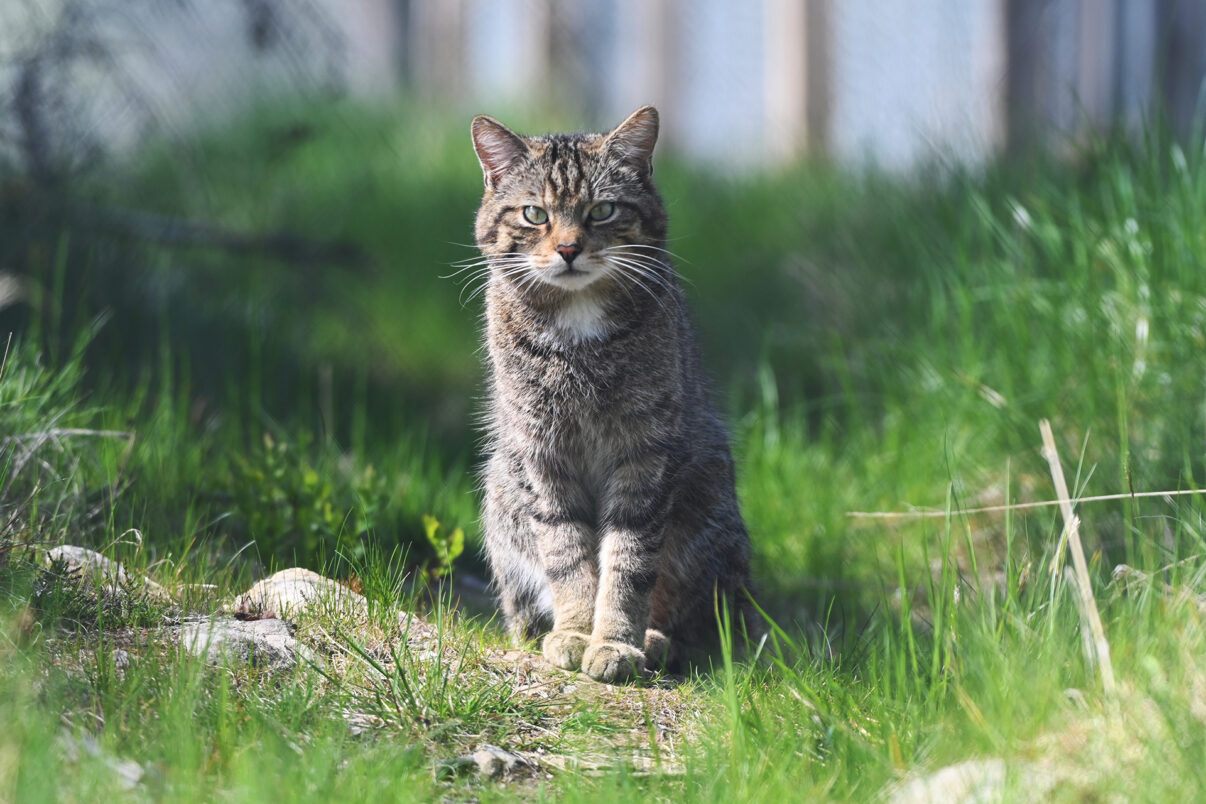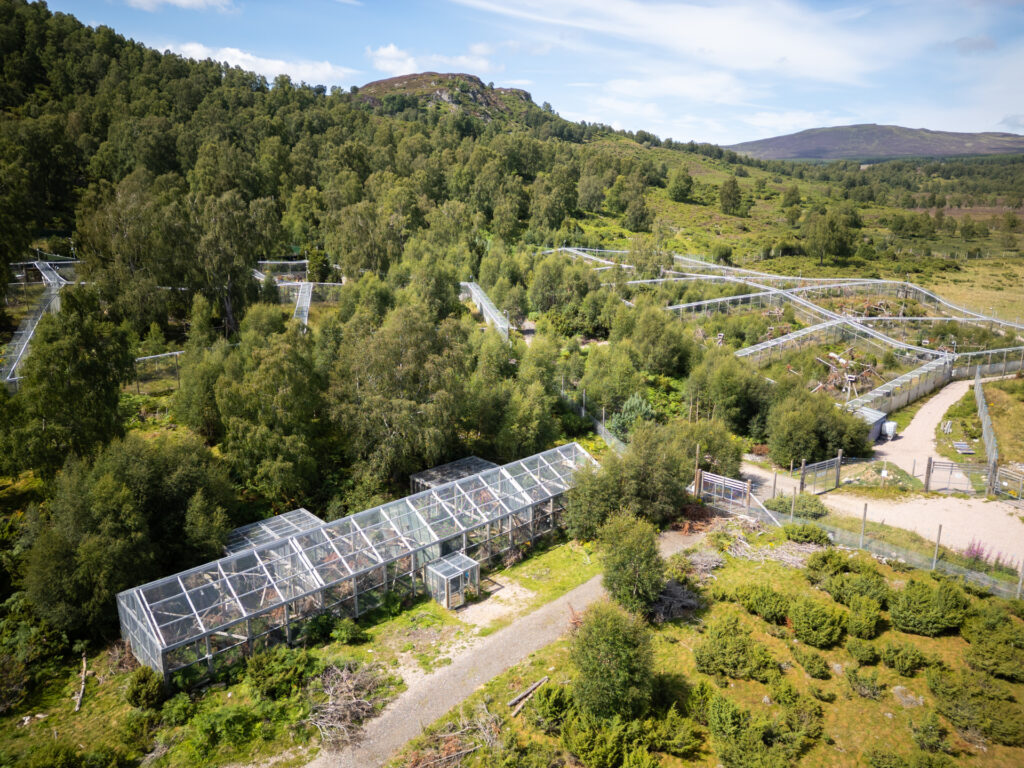Over the last three years, grants from Rewilding Europe’s European Wildlife Comeback Fund have supported the release of over 35 wildcats in the Highlands of Scotland. With animals from this restored population already breeding, the future of the iconic Scottish wildcat looks more optimistic.

A more hopeful future
The future of wildcats in the Highlands of Scotland looks more hopeful, with a population of animals released into the wild since 2023 currently thriving. Supported by two grants from Rewilding Europe’s European Wildlife Comeback Fund, the Saving Wildcats initiative has released over 35 cats into the Cairngorms National Park over the last three years, with further releases ongoing. The initiative is also a member of Rewilding Europe’s European Rewilding Network.
The vast majority of these animals have survived and appear to be flourishing in the wild, with camera and GPS tracking revealing that seven females gave birth to litters of kittens in 2024, and at least five have given birth this year. This is highly welcome news for Scottish wildcats – a sub-population of the European wildcat that has declined to the point of near extinction in recent decades. It is also good news for nature in general, as wildcats are an ecologically important species, helping to keep local ecosystems in balance.
“We’re delighted with the results of the restoration programme so far,” says Dr. Helen Senn, project lead for the Saving Wildcats partnership, which is working to save Scottish wildcats and is led by the Royal Zoological Society of Scotland, together with a range of other partners. “The fact that litters of kittens were born and raised the year after the first wildcats were released is testament to the fact the animals are doing well. It’s too early to make long-term predictions, but this is definitely a step in the right direction.”
Back from the brink
The cats released into the Cairngorms National Park through the Saving Wildcats initiative are offspring of animals sourced from members of the UK’s conservation breeding programme. These animals have been raised in a conservation breeding for release centre in an off-show area at the Royal Zoological Society of Scotland’s Highland Wildlife Park. The release of cats in 2023 was the first-ever conservation translocation of wildcats in the UK.
The Saving Wildcats initiative is helping to turn around the long-term decline of wildcats in Scotland. European wildcats were once widely distributed across the United Kingdom, but habitat loss and persecution saw their range and abundance diminish from the turn of the twentieth century onwards. The species is now limited to northern and eastern Scotland and is listed as critically endangered.
The remaining Scottish wildcat population is threatened by hybridisation with domestic cats. Since all individuals sampled in the wild in recent years have shown a high degree of such hybridisation, the population is now considered functionally extinct. An IUCN report published in 2019 concluded that the last hope for the Scottish wildcat was to breed captive individuals for release into the wild.

Maximising the chance of success
The landscape where the wildcats have been set free was extensively surveyed prior to their release. It was concluded that restoration of a local wildcat population would be highly unlikely to have a negative impact on the ecology of the area – through predation on capercaillie, for example – and that the cats would have enough natural food to sustain them. Out of the 35-plus cats released into the Cairngorms to date, there have so far only been four known mortalities, a lower number than would usually be expected, given the experience of similar initiatives internationally. While scientific monitoring and reporting for the initiative is still in progress, this is an extremely heartening outcome for a carnivore release programme.
“We believe there are a number of reasons for this success,” explains Dr. Helen Senn. “We carry out extensive veterinary checks to ensure the cats are in good health prior to their release. We also conduct behavioural monitoring and enrichment in the breeding for release centre, ensuring the cats exhibit behaviours that will enable them to survive in the wild, such as stalking and pouncing.
“Once the wildcats have been released, we provide supplementary food on a temporary, case-by-case basis to ease their transition. And last but not least, most of the cats have stayed within the area of the Cairngorms National Park where they were released and have had kittens, so we think they must be comfortable enough in their new home. We learn more every day about this fascinating species through GPS tracking and can use the information gathered to inform future releases.”
Community engagement
Extensive stakeholder engagement has helped to generate considerable support for the release of wildcats in the Cairngorms area, particularly among local communities. Initiatives such as offering a local primary school the opportunity to name one of the recently released cats helps to fuel this engagement moving forwards.
Saving Wildcats is also working with local residents directly affected by predation of backyard poultry by released wildcats. A few stakeholders are currently trialling the loan of predator-proof coops and runs provided by the initiative. The team provide and construct the coops and runs and then monitor them using trail cameras to ensure they’re providing effective protection.
Saving Wildcats are also keen to share their work with their local community – in the autumn a feature-length documentary film narrated by well-known actor Sam Heughan – called “Clinging by a Claw” – will premiere in selected venues across Scotland, offering the partnership’s stakeholders a chance to gain an extraordinary insight into the return of Scotland’s wildcats.
Nature-based tourism potential
There has been growing interest from people hoping to catch a glimpse of the elusive felines in the wild.
“It’s still early days, but the increasing presence of wildcats in the Cairngorms could certainly support the growth of sustainable nature-based tourism,” says Dr. Helen Senn. “We’ve already had a lot of interest from tourists and are currently developing various tour options. We ran a wildcat-focused tour in collaboration with a local wildlife experience provider last year, which was a great success. Of course, it’s critical that any tours to see wildcats in the wild are conducted sensitively and we are very mindful of that in our approach.”

Looking to the future
The recovery of the Scottish wildcat population will take many more years and the establishment of populations over an area wider than just the Cairngorms. Yet the initial success of the Saving Wildcats initiative shows that reintroduction programmes can have positive outcomes, backed up by other conservation measures such as habitat protection and enhancement, and efforts to mitigate hybridisation. Feasibility studies for wildcat reintroductions have now begun in England and Wales.
With Saving Wildcats still developing plans for 2026 and beyond, further releases through the initiative are a possibility.
“Such releases might be more targeted,” says Dr. Helen Senn. “For example, we might release a male into an area where there are a lot of females in order to boost genetic diversity and reduce the risk of hybridisation. We will also continue to monitor the wildcats that have been released between 2023 and 2025, and their offspring.”
Let’s rewild together
The agile setup of the European Wildlife Comeback Fund is designed to support wildlife comeback in a convenient and flexible way. Rewilding Europe invites other initiatives working to reintroduce keystone species in European landscapes to consider applying for a grant. Those interested in contributing to wildlife recovery in Europe can support wildlife comeback with a donation.




